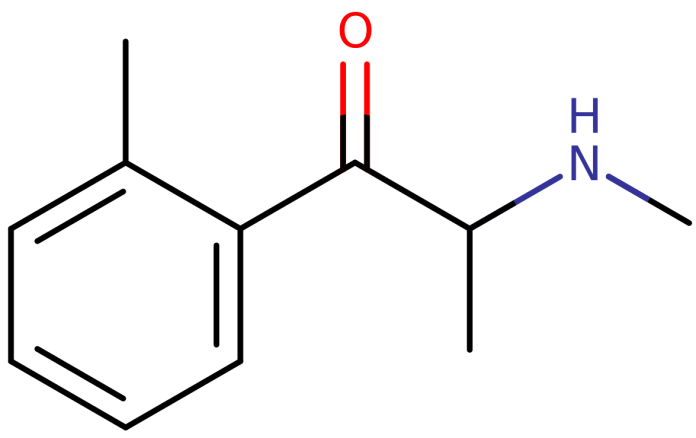When it comes to designer drugs, 2-Methylmethcathinone is one worth reporting on. In this article, we’ll dive into the history of 2-MMC, dosages, administration methods, user reviews, effects, and potential side effects. By the end, you’ll have a comprehensive review of this controversial and legally questionable research chemical.
General Information on 2-MMC
Let’s begin our research chemical review by going over general information on this drug. 2-MMC, also known as 2-methylmethcathinone or ortomephedrone, is a synthetic stimulant in the cathinone (natural plant stimulant) family. It’s often compared to other cathinones like Mephedrone and Methamphetamine. It’s known for causing potent stimulation. The 2-MMC research chemical was first created in 1928. However, it didn’t become popular until the early 2000s when it was still part of the legal drugs category in more regions. At that time, it started being marketed as a “research chemical” in online stores.
History of 2-MMC
2-MMC’s history is somewhat murky. As mentioned, it was likely first synthesized in 1928. The drug’s creator, a Romanian chemist named Lazăr Edeleanu, was looking for a manufactured version of the plant khat. This unique plant contains the natural stimulant cathinone. To expand further, khat has a long history of traditional use in some African and Arabian cultures. However, it’s also a controlled substance in many countries because of its potential for abuse and addiction.
It wasn’t until the early 2000s that the 2-MMC research chemical started getting well-known as a “research chemical” in online marketplaces. By the mid-2000s, 2-MMC was more widely available and was sold under the name “Mephedrone” or “Meow Meow”. It made a name for itself as a club drug. In many cases, people used it in combination with other drugs like MDMA and cocaine. Then, in 2010, the UK banned Mephedrone and other cathinones, due to concerns about their safety and abuse potential.
Since then, 2-MMC has remained a controversial substance, with some users praising its effects and others warning about its potential dangers. The legality of 2-MMC is unknown or undefined in many countries, so users looking for legal highs may come up short. It’s still probably legal in
Dosage and Administration
Like most stimulants, 2-MMC’s effects depend on the dose size. A typical recreational dose is between 50-150mg. The effects can last between 2-6 hours. However, everyone’s body is different, so some people are more sensitive to the effects of the 2-MMC research chemical than others.
Oral Administration
The most common way to take 2-MMC is orally, usually in the form of a capsule or tablet. It’s important to start with a small dose and wait to see how your body reacts before taking more. Some users report a delayed onset of effects when taking 2-MMC orally, with the effects taking up to an hour to kick in.
Nasal Insufflation
Another popular way to take 2-MMC is through nasal insufflation, or “snorting”. This method is generally considered to be more intense than oral administration, with the effects kicking in more quickly and lasting for a shorter amount of time. However, snorting 2-MMC can be more damaging to the nasal passages and may increase the risk of addiction and overdose.
Vaporization
Vaporization is a less common method of taking 2-MMC, but it’s still used by some users. It involves heating the substance until it vaporizes, then inhaling the vapor. Vaporization is generally considered to be more intense than oral administration but less intense than nasal insufflation.
Suppository
Suppositories are a less common method of taking 2-MMC, but they can be effective for some users. They involve inserting the substance into the rectum, where it’s absorbed by the body. This method is generally considered to be more intense than oral administration, but it can also be more unpredictable and difficult to dose accurately.
Redosing
Some users choose to redose the 2-MMC research chemical during a session to prolong the effects or to raise their intensity. However, redosing can increase the risk of side effects and can also lead to addiction and overdose. It’s important to be cautious when redosing and to wait until the effects of the initial dose have worn off before taking more.
User 2-MMC Reviews
User reviews of 2-MMC are mixed. Some users report a euphoric high and increased sociability, while others report negative side effects like anxiety, paranoia, and insomnia. Some users have also reported a “hangover” or “comedown” effect after the drug wears off, which can include feelings of depression and fatigue.
Onset of Effects
The onset of 2-MMC’s effects can vary depending on the administration method. Oral administration usually takes longer to kick in, with effects taking up to an hour to appear. Nasal insufflation and vaporization both have a faster onset, with effects appearing within minutes. Suppository administration can also have a relatively fast onset.
Euphoria
The euphoric effects of 2-MMC, which is a synthetic stimulant, can be described as a rush of intense pleasure and well-being accompanied by increased sociability and confidence. Users may feel a sense of happiness and contentment, with a more appreciation for their surroundings and a strong desire to be social. The euphoria is thought to be caused by the drug’s ability to increase dopamine levels in the brain, leading to feelings of pleasure. However, the euphoric effects can be short-lived.
Increased Alertness & Focus
The 2-MMC research chemical is known to increase alertness and focus in users. The drug achieves this effect by stimulating the central nervous system, which triggers the release of certain neurotransmitters in the brain. Specifically, 2-MMC boosts the levels of norepinephrine and dopamine, which are associated with alertness, attention, and focus.
As these neurotransmitters are released, users often report feeling more awake and aware. They may feel a heightened ability to concentrate on tasks or conversations. Users may also feel more quick-witted and better able to problem-solve and think creatively.
Anticlimax (“Comedown”)
After the effects of 2-MMC wear off, some users may experience an “anticlimax” or “comedown” effect. This can include feelings of depression, fatigue, and irritability, as well as physical symptoms like headaches and muscle aches.
Potential Side Effects of 2-MMC
As the last section of our 2-MMC review, we’ll cover a very critical topic: side effects. Like all drugs, 2-MMC has potential side effects, some of which can be very serious or even fatal. Common side effects include the following:
- Increased heart rate and blood pressure
- Pupil dilation
- Dry mouth
- Insomnia
- Anxiety and paranoia
- Nausea and vomiting
- Muscle tension and tremors
In rare cases, 2-MMC may cause more serious side effects like seizures, psychosis, and cardiovascular problems. Be aware of these potential side effects and seek medical attention immediately if you experience any symptoms.


